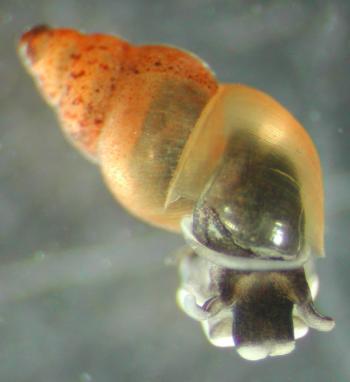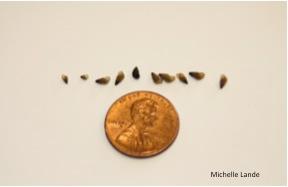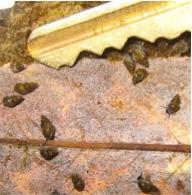New Zealand Mudsnail
-
Scientific Name
Potamopyrgus antipodarum - Visit ITIS for full scientific classification.
-
Description
 New Zealand Mudsnail. Ken Davis. © Regents, University of California.
New Zealand Mudsnail. Ken Davis. © Regents, University of California. New Zealand Mudsnail. Michelle Lande. © Regents, University of California.
New Zealand Mudsnail. Michelle Lande. © Regents, University of California. New Zealand Mudsnail. Sabrina Drill. © Regents, University of California
New Zealand Mudsnail. Sabrina Drill. © Regents, University of California- Very small, average size is around 1/8 of an inch, and can be as small as grain of sand.
- Single grey, brown, or black shell with 5-6 spirals
- Covered with a protected plate, called an operculum, when foot is retracted.
- Easily confused with native snails such as Physa sp., Pyrgulopsis sp., Fossaria sp., Fluminicola sp., and others.
-
Habitat
- Can be found over mud, sandy, or rocky substrates; and on vegetation.
- Has a high tolerance to changes in water quality.
-
Invasion Pathways and Distribution
- Native to New Zealand.
- Widely distributed in California.
- Introduced into Idaho via shipment of fish eggs for hatchery operations.
- Continued to spread via human activities including fishing.
- Believed to have spread by attaching to recreational equipment including waders, boots and other fishing gear.
- Possibly dispersed by fish because they are capable of surviving passage through the digestive tracts.
- Visit USGS for a current U.S. distribution map.
-
Life History
- Nocturnal grazer.
- Feeds on detritus, algae and sediments.
- Live birth.
- Females are born with developing embryos.
- Individuals are capable of both sexual and asexual reproduction.
-
Impacts
- Outcompetes natives for resources.
- New Zealand mudsnails themselves provide very low quality food for other animals, as most predators cannot digest the animal inside it's shell.
- A single animal can start a new infestation due to asexual reproduction.
- Can survive out of water by sealing it's shell, and can pass through a fishes' digestive tract.
-
References and Useful Links
For references by category and links to other useful AIS sites see our LEARN MORE page.



